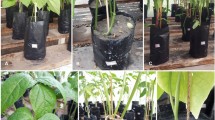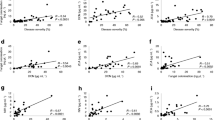Abstract
Fusarium moniliforme Sheldon is an economically important pathogen of corn (Zea mays L.) which causes stalk, root and ear rot. Several mycotoxins have also been isolated, identified and implicated in both animal and human toxicoses. The fungus can be disseminated in symptomless corn seed and can also survive in crop residues in the soil. Asymptomatic infection may be related to different corn cultivars, fungal strains, and environmental factors. Symptomatic expression of pathogenicity may vary, but usually the result of such infections is death of the plant. The greatest concern is the asymptomatic infection, since it is in this form that fungal toxins may surreptitiously enter animal and human food chains. F. moniliforme produces both fusaric acid, which is phytotoxic to corn and interferes with seed germination, and plant growth regulators that may affect pathogenicity of the fungus or be associated with the production of mycotoxins. Other metabolites, including fusarin C, moniliformin, and the fumonisins, may or may not be phytotoxic, but are associated with animal and human toxicoses. The control of F. moniliforme in corn is therefore quite important. One potential means to accomplish this reduction is biocontrol by the application of antagonistic rhizobacteria to corn kernels at planting. To be effective the bacteria must be able to colonize the corn root system and be able to prevent root infection by successful competing with F. moniliforme which may be accomplished by siderophore and or antibiotic activity.
Similar content being viewed by others
References
Nyvall RF, Kommedahl T. Saprophytism and survival of Fusarium moniliforme in corn stalks. Phytopathology 1970; 60: 1233–5.
Kommedahl T, Windels CE. Root-, stalk-, and ear-infecting Fusarium species on corn in the USA. In: Nelson PE, Toussoun TA, Cook RJ, eds. Fusarium: Diseases, biology and taxonomy. University Park: The Pennsylvania State University Press, 1981: 94–103.
Booth C. The genus Fusarium. Kew, Surrey (UK): Commonwealth Mycological Institute, 1971.
Marasas WFO, Nelson PE, Toussoun TA. Toxigenic Fusarium species, identity and mycotoxicology. University Park: The Pennsylvania State University Press, 1984.
Headrick M, Pataky JK. Relationships among carbohydrates content of kernels, condition of silks after pollination, and the response of sweet corn inbred lines to infection of kernels by Fusarium moniliforme. Phytopathology 1990; 80: 487–94.
Warren HL. Comparison of normal and high-lysine maize inbreds for resistance to Fusarium moniliforme. Phytopathology 1978; 68: 1331–5.
Foley DC. Systemic infection of corn by Fusarium moniliforme. Phytopathology 1962; 52: 870–2.
Pennypacker BW. Anatomical changes involved in the pathogenesis of plants by Fusarium. In: Nelson PE, Toussoun TA, Cook RJ, eds. Fusarium: Diseases, biology, and taxonomy. University Park: Pennsylvania State University Press, 1981: 400–8.
Bacon CW, Siegel MR. The endophyte of tall fescue. J Prod Agric 1988; 1: 45–55.
Farber JM, Sanders GW. Fusarin C production by North American isolates of Fusarium moniliforme. Appl Envir. Microbiol 1986; 5: 381–4.
Toussoun, TA. Fusarium-suppressive soils. In: Bruehl GW, ed. Biology and control of soil-borne plant pathogens. St. Paul, MN: American Phytopathological Society, 1975: 145–51.
Zak JC. Pathogenicity of a gibberellin-producing and a nonproducing strain of Fusarium moniliforme in oats as determined by a colorimetric assay for N-acetyl glucosamine. Mycologia 1976; 68: 151–7.
Drysdale RB. The production and significance in phytopathology of toxins produced by species of Fusarium. In: Moss MO, Smith J, eds. The applied mycology of Fusarium. New York: Cambridge University Press, 1984: 95–105.
Malini S. Heavy metal chelates of fusaric acid: In vitro spectrophotometry. Phytopath Z 1966; 57: 221–31.
Tamari K, Kaji J. Studies on the mechanism of the growth inhibitory action of fusarinic acid on plants. J Bacteriol 1954; 41: 143–65.
Banwart WL, Bremner JM. Formation of volatile sulfur compounds by microbial decomposition of sulfur-containing amino acids in soils. Soil Biol Biochem 1975; 7: 359–64.
Bacon CW, Marijanovic DR, Norred WP, Hinton DM. Production of fusarin C on cereal and soybean by Fusarium moniliforme. Appl Environ Microbiol 1989; 55: 2745–8.
Cole RJ, Kieksey JW, Cutler HG, Doupnik BL, Peckham JC. Toxin from Fusarium moniliforme: Effects on plants and animals. Science 1973; 179: 1324–6.
Bottini AT, Gilchrist DG. A 1-aminodimethylheptadecapentol from Alternaria alternata f.sp. lycopersici. Tetra Let 1981; 22: 2719–22.
Siler DJ, Gilchrist DG. Properties of host specific toxins produced by Alternaria alternata f. sp. lycopersici in culture and in tomato plants. Physiol Plant Pathol 1983; 23: 265–74.
Thakur MS, Vyas KM. Production of plant growth regulators by some Fusarium species. Folia Microbiol 1983; 28: 124–9.
Schroth MN, Loper JE, Hildebrand DC. Bacteria as biocontrol agents of plant disease. In: Klug MJ, ed. Current perspectives in microbial ecology. Washington, DC: American Society for Microbiology, 1983: 362–9.
Hemming BC. Bacteria as antagonists in biological control of plant pathogens. In: Baker RR, Dunn PE, eds. New directions in biological control: Alternatives for suppressing agricultural pests and diseases. New York: Alan R. Liss, 1990: 223–42.
Swinburne JR. Iron, siderophores, and plant disease. New York: Plenum Press, 1986.
Author information
Authors and Affiliations
Rights and permissions
About this article
Cite this article
Bacon, C.W., Williamson, J.W. Interactions of Fusarium moniliforme, its metabolites and bacteria with corn. Mycopathologia 117, 65–71 (1992). https://doi.org/10.1007/BF00497280
Received:
Accepted:
Issue Date:
DOI: https://doi.org/10.1007/BF00497280




